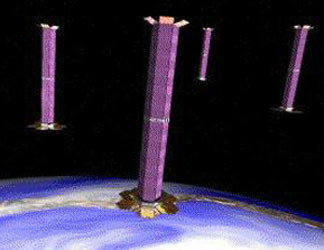News: SLAB awarded a NASA grant for miniaturized distributed space systems
By Jan Kolmas October 27, 2014

Artist’s rendering of TechSat-21 (credits: AFRL, NASA)
The miniaturization of satellites is a topic making many headlines recently, but not new to Stanford at all. The Space Systems Development Lab has been developing small satellites for over two decades. This technology, combined with the distribution of tasks among multiple coordinated satellites promises breakthroughs in space science, surveillance, and exploration.
These so called distributed space systems open the scene for novel mission architectures, such as a new generation of space telescopes, Earth imaging by radar or affordable asteroid prospecting.
Despite their potential, little to no studies are available today which describe the actual capabilities of these platforms in a systematic way. Supported by the NASA grant #NNX14AP35G, the Space Rendezvous Lab (SLAB) is spearheading the effort to map and characterize the possibilities opened by this new technology.
SLAB’s Principal Investigator, Prof. Simone D’Amico says that this study will provide guidelines for design of future distributed space systems. He also hopes that this project will help guide research in the lab and eventually culminate in a preliminary mission design.
“The output of this study is expected to consolidate the motivation for the research and development roadmap of the Space Rendezvous Lab at Stanford and possibly lead to a joint mission proposal together with NASA Ames,” D’Amico said.
Jan Kolmas is a graduate student in Stanford’s Space Rendezvous Lab


